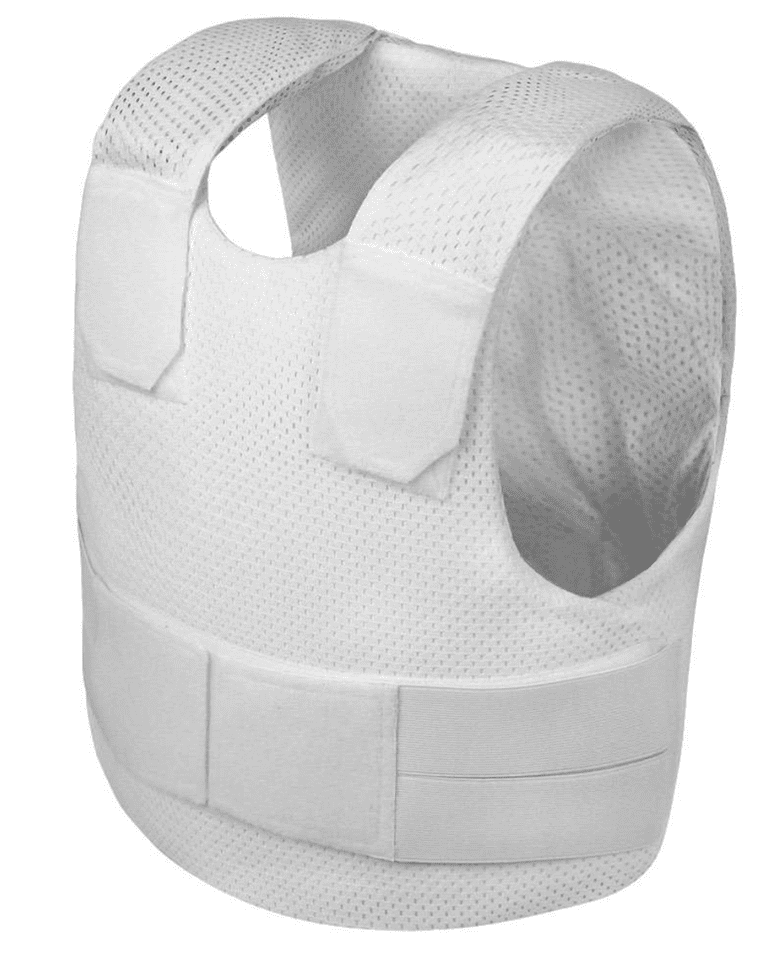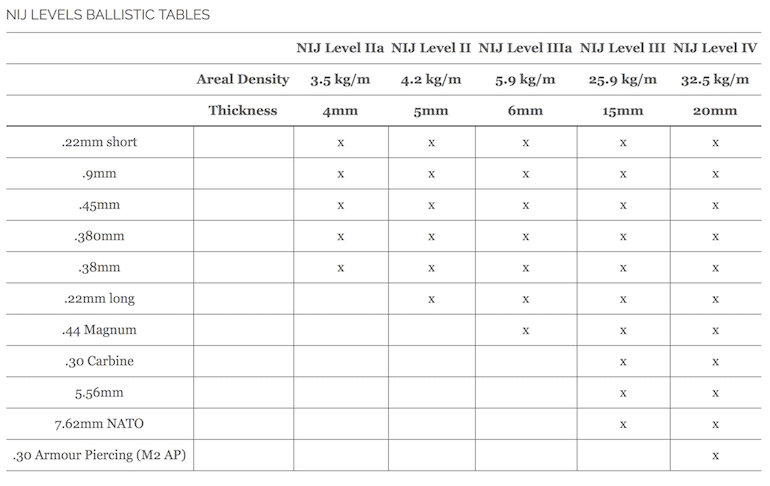Benjamin Atkinson, Communications Executive at SafeGuard ARMOR, writes:
Ballistic body armor has saved thousands of Americans from death or serious injury. While body armor is part of the standard equipment for law enforcement officers, gun enthusiasts are only now beginning to adopt the technology in large numbers. And why not? With modern advancements in production and design . . .
body armor is no longer bulky and heavy. It’s more effective. And cheaper.
So which vest is right for you? There are many different standards for ballistics protection levels. Understanding the different levels of available armor helps you determine which is most suitable for your budget and potential threats.
Body Armor Levels – Ballistics
The two most commonly recognized standards for body armor come from the US National Institute of Justice (NIJ) and the UK Centre for Applied Science and Technology (CAST, formerly HOSDB).
These two orgs are widely held to be the world leaders in standardizing body armor. They often share testing methods; armor that meets the standards of one will meet the requirements of the equivalent.
These standards outline exactly what threats each level of body armor will protect against, as well as the strength of the attack it will stop. This means that a bullet proof vest at Level II for example will not protect against a Level IIIa threat. But what do these levels mean?
Bullet proof vests are designed to ‘trap’ and slow bullets down as they attempt to pass through the vest. Bullet Proof Vests come in two different types; hard and soft. The ‘soft’ armors are designed to protect against most handgun and small arms ammunition, whereas ‘hard’ armors are designed to stop high caliber and armor piercing rounds.
The NIJ classifies body armor as follows:
Body Armor Levels – Edged Weapons
Many assume that if a piece of body armor can stop a bullet, it can stop a knife. This is not necessarily the case. Stab proof vests are different in make up to bullet proof vests.
You can buy multi-threat vests that can protect against both, but these still need to be graded according to the protection they offer against both bullets and edged/spiked weapons. The threat levels for stab proof vests are standardised by the CAST as follows:

The Simple Choice
A Level IIIa vest is the most commonly used body armor.
Level IIa is soft armor rated for pistol rounds and light fragmentation. As shown above, it offers good protection against 9mm, .40 S&W and .45 ACP rounds. Many consider Level IIa the bare minimum armor protection.
When it comes to a decent array of pistol weapon threats, versatility and affordability, Level IIIa is the simple, affordable choice. That’s the rating current law enforcement standard. Level IIIa body armor offers enhanced protection up to .44 mag and .357 SIG (a relatively high velocity round for a handgun).
Overt or Covert
Apart from protection levels, there are two types of tactical body armor styles: overt and covert (concealable).
Non-LEO buyers generally find that covert vests offer greatest advantages. They’re useful in a large range of scenarios — as opposed to hard armor which is impractical for daily use. Covert body armor offers reduced chances of detection, which can save your life. Attackers won’t aim for unprotected body parts.
And don’t forget comfort. Body armor isn’t one-size fits all. The best vests are adjustable to better fit the user’s body type and range of motion. And some use breathable fabrics for hot weather climates.
Ballistic plates
One of the best advancements in the field of body armor: lightweight ballistic plates.
A vest that accommodates ballistic plates radically increase a vest’s protective capabilities. That said, they add some weight and bulk, potentially limiting covert capability.
The best solution: buy a Level IIIa ballistic vest that takes lightweight ballistic plates. Mate the two as and when the situation requires.
——————————–
Benjamin Atkinson is the Communications Executive at SafeGuard ARMOR™, a leading international body armor manufacturer. SafeGuard ARMOR™ have invested years of research and industry expertise into the development of high performance body armor that is lighter, more flexible, more comfortable with unbeatable protection.






Finally, I can buy armor to protect me against a hail of dreaded .9mm bullets.
And the even more feared .22mm round.
Hey, the .45mm is TWICE the size of your .22mm. (And half the size of the .9mm.)
If anyone needs a reason why body armor is an answer to a question no one is asking, this is it.
Typo:
“Level IIa body armor offers enhanced protection up to .44 mag and .357 SIG (a relatively high velocity round for a handgun).”
Should be “Level IIIa” ?
In any case, as someone who has worn a concealable vest plenty (both II and IIIa) I suspect most people would do better with a plate carrier to keep in their trunk, home, etc. Cost, ease of sizing and speed of wearing all favor them. But whatever floats your boat.
I was an adventurer. Until I took an arrow to the knee.
Hundreds of dollars to protect my vitals and the f*cker shoots me in the knee. With an arrow.
No more adventures for me. Anybody want to buy a vest that’s never been shot? Only been sweated in by a fat man. Anybody?
Guy killed me, Mal. Killed me with a sword. How weird is that?
This and the comment above are why I come here. Keep your gun and gear reviews, your comments section gets Bethesda and Serenity. Proof that no greater group of armed intelligensia exists, well done both of you!
Civil war is right around the corner, I have 111A but need 111 ceramic plates. But new armor will be coming out that will amaze you made from carbon. See you on battle field
I view body armor as an outlier event precaution, and to that end I keep a set of hard armor by the bed for the possibility of a midnight intrusion. I am thinking of getting another set for the car in case of urban unrest. My armor is rifle rated because I see no reason not to.
The only use I see for soft armor is if you wear it every time you are in public or if you put it on when you go to particularly dangerous areas. I don’t go to known dangerous areas, so I, personally, have no use for soft armor.
Gentlemen don’t wear body armor.
Their valet wears body armor.
I will be quoting this remorselessly!!
Where does a bulletproof shield fall into this mix? I just don’t see there being enough time to don a vest during a home invasion. I could possibly see picking up a shield placed conveniently by the night stand, though.
If the home invaders actually yelled “POLICE” when their written reports say they yelled it, you’d have time to put on hard armor before they made it to your bedroom.
That’s an interesting choice. A ballistic shield actually kinda makes sense. You could even put a spike on the front incase someone tried to grab it, then you could jab the spike into them. Or even a ballistic shock shield, with protruding electrodes that would electrocute someone that grabbed it. Funny how combat seems to go in circles.
As the owner of both a IIIa ‘soft’ or Kevlar concealment vest AND a lvl IV set of rifle plates in carrier I’m surprised I’ve never seriously considered a ballistic shield. I thought of them as unwieldy and unlikely to come along to the fight. . . while at the same time I don’t even keep either set in the bedroom as putting either on after awakening to the classic ‘bump in the night’ seems a bit slow, especially the hard plate. . . I’d break my nose trying to do that sleepy and rushed. A ballistic shield now seems to be the thing to have for that. . . I’m wondering if I can build a rack to rest one or both of my rifle plates in so as to allow them to be used as a shield. I figure bonus points if I build it so that the plates will ride in it carrier and all, allowing for the ‘shield frame’ to be stripped and the armor body worn very quickly, situation allowing.
One vital point that the article neglected to mention is that vests typically have a five year life span
Another key point, if you carry daily especially in a profession of exposed carry, always wear a level of body armor that is at least equal to your EDC sidearm.
The most likely threat is being shot with your own firearm. Even for law enforcement.
It would be nice if the article covered the potential advantages of trama pads too.
Difficult to take advice about ballistic protection seriously from an author who doesn’t understand caliber measurements.
That’s why I stopped reading the article.
Comments are closed.